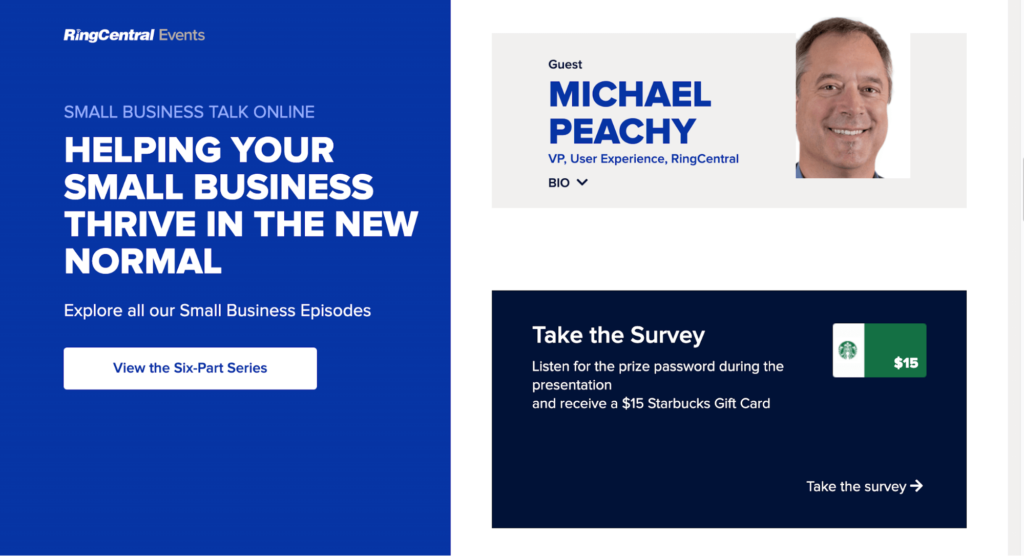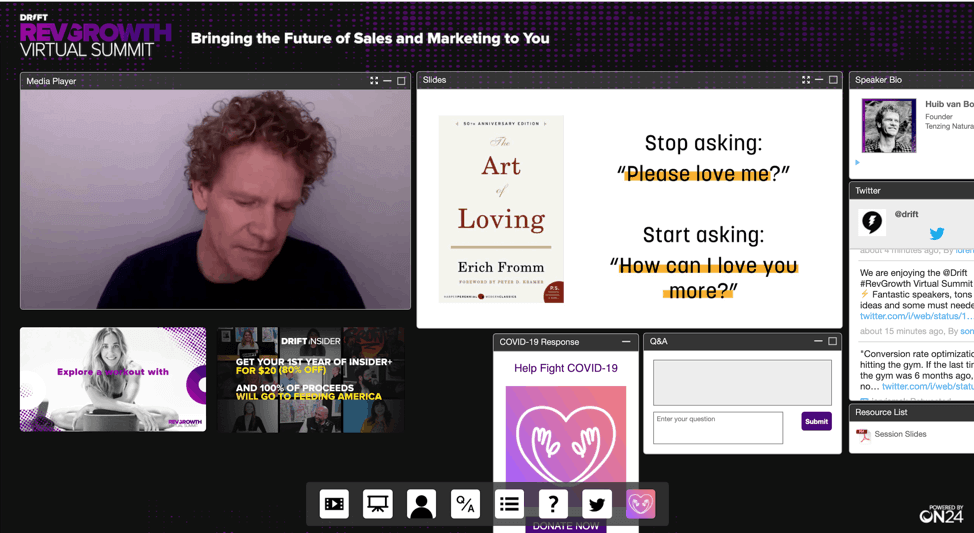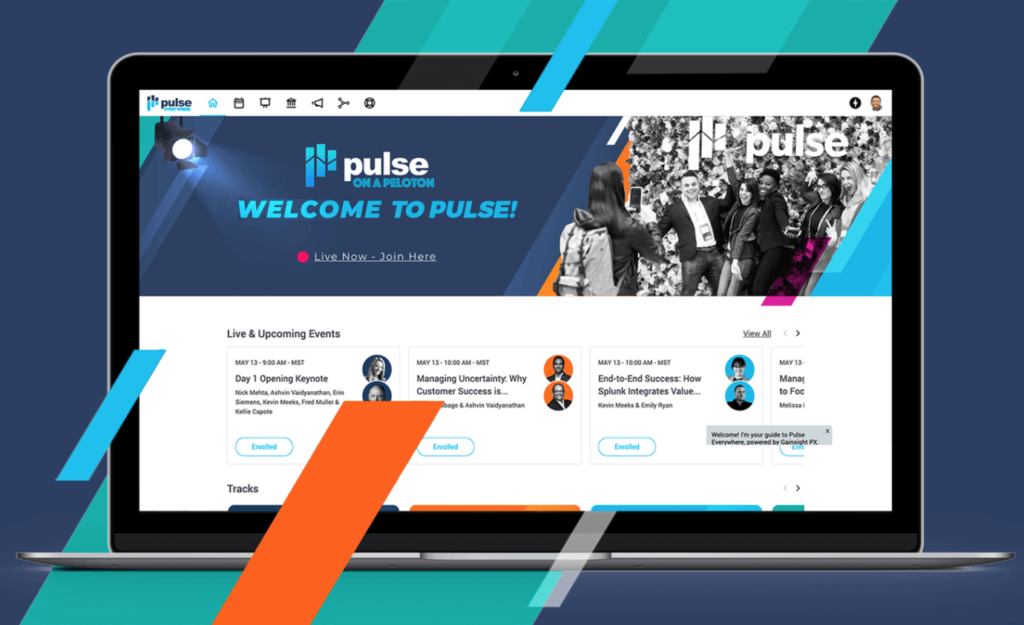Digital transformation (DT) has been a top priority for what seems like forever. In 2019, directors, CEOs, and senior executives were most concerned with DT risk, but an estimated 70% of all DT initiatives failed to reach their goals, wasting an incredible $900 billion that year.1
When COVID-19 hit, already struggling businesses were vaulted five years ahead in consumer and business digital adoption in a matter of around eight weeks.2 Mammoth events like SXSW, Silicon Valley crowd-pullers like Facebook’s F8 and Google’s I/O had to cancel or be postponed, sending about $1B down the drain.3
How do you respond during a crisis when you have a live, very expensive event (that you spent months planning) coming up?
By going virtual, of course—and fast.
But this is uncharted territory. How do you get virtual events to be as social, dynamic, and interesting as live events? There isn’t a playbook, but there are great ideas and techniques that have worked.
At RingCentral, we’ve built a powerful communications solution for online meetings, webinars, and large conferences, so if you have a full schedule in the coming months, keep reading.
In this article, we’ll show you how our digital events team, led by Rose Maugeri, VP of Strategic Events—along with a few examples from other successful companies—get it done.
We’ll cover:
- What’s a “digital event experience”?
- What are the advantages of running events in this way?
- How do you create a digital event experience?
- 4 examples of digital event transformations (and ideas from behind the scenes)
What’s a digital event experience?
Conduct an event entirely online, and your attendees have a digital event experience. That’s simple enough. Everything including registrations, leaderboards, gamified competitions, keynote presentations, and networking, takes place virtually.
Almost every kind of event can be adapted to digital—conferences, seminars (hello, webinars), trade shows, open houses, shareholder meetings, panel discussions, a product launch, or even a museum tour.
Advantages of running events online
More digital events today are virtual because of necessity more than choice. But they don’t have to be sorry replacements for live events—they can be a better way to do business. Here are three reasons why:
1. Online events are less expensive to produce
With digital events, you don’t have to book a conference hall, arrange for food and beverages, or spend on decor and logistical knick-knacks. You can allocate those funds to getting more expensive speakers from anywhere in the world, more enticing goodie bags, and developing interesting content.
2. Online events are more accessible to attendees
Since they’re cheaper to produce and accessible from anywhere on earth with an internet connection, online events are much more accessible to attendees. And a more accessible event means a higher rate of attendance. In May, Bloomberg Quint reported that Wall Street saw double the turnout at their suddenly virtual events, sometimes more.4
3. You get tons of interactive content
If you’re using tools like RingCentral Video or even RingCentral Rooms, you can record your digital event experience and repurpose it into an on-demand webinar at a later stage. You could turn the transcripts of panel discussions into SEO-optimized blog posts to draw traffic to your website.
You could also continue discussions that began during the event on social media to encourage audience engagement. The possibilities are limitless and also far easier to execute than if you were working on a live event.
How do you create a digital event experience?
It’s important to note that adapting an event online doesn’t mean that the format can be replicated without considering the nuances. People consume content very differently in front of a computer compared to in a conference hall, and you have to put thought and care into architecting information in an engaging way.
As Rose has observed, “A lot of folks are just picking up what they’re doing in person and moving it online and saying ‘we’re moving virtual’ because our content is on there. But there’s more to it than that.”
So how can one go about creating a memorable digital event experience?
1. Define your goals
What do you want to achieve with the digital event? Are you hoping to please your sales team with a boatload of qualified leads? Or perhaps appease your sponsors with a ginormous attendee list—or both?
Get out your whiteboard, virtual or not, and write out your stakeholders. This includes your sponsors, your target audience, and everyone else involved. What are your priorities and goals for the event you’re planning?
2. Create an outstanding program
After months of fighting cabin fever working from home, people are suffering from screen fatigue. You’re looking to engage a bleary-eyed audience that’s been spending much of the day trying not to multitask during endlessly boring virtual meetings. And virtual events are a dime a dozen. What this means is that it’s time to push the limits of what a digital event experience can be.
For example, you could experiment with immersive AR and VR experiences rather than videos. While a speaker is talking, why not have an artist create a graphic recording that’s later distributed through your content marketing program? It’d definitely be a lot more interesting than an ordinary PowerPoint.
That being said, it’s important not to get caught up in the technology (though that’s critical) while you’re planning content. Think about how you can present it in a way that’s conducive to this new format. Here are a few tips from Rose:
1. Figure out the story
“Think about the story you want to tell in areas that are top of mind for your audience. We have to think about what the customer cares about. As a brand, you have to be human and bring out that perspective, whether that’s in the physical or digital space.
Figure out the story you want to tell, (that’s the) red thread that connects everything together.”
2. Present concisely
“You’re giving a presentation that stands alone. You’re trying to mirror TV almost. Think about how people watch TV—they may not watch commercials, but they do expect (them). You need to be able to tell stories while keeping those brief pauses in mind.
You can’t just do a one hour presentation at a time and expect people not to get up or get distracted. Even I tune out. It’s hard to stay on a meeting for an hour! We’ve found that seven minutes at a time is the sweet spot.”
3. Present emphatically
“One thing that is often overlooked is that people can’t always read gestures or tone well on video; so you have to exaggerate your movements and expressions a little more.
You might think you’re smiling and emoting and then you look at yourself on camera later and you’re like, ‘Wow, was I bored or what?’”
4. Chill out
“One of the critical things for small businesses when thinking about digital events is knowing that people are accepting of a less ‘produced’ environment. Less fancy, shorter time frames and commercial breaks. We don’t necessarily need the big production value.
Lots of people think we need sexy PowerPoints and animation, but by now people are really used to dogs barking in the background or kids playing. As long as you have a good sense of humor about it, your attendees will think it’s okay too. Being crisp, concise, and clean in how you communicate on-screen is more important.
And have a little fun! Don’t sweat the small stuff. People aren’t looking for perfection; they’re looking for information—and sometimes, a little entertainment.”
3. Get your tech in order
The logistics of video conferencing are arguably easier and less time-consuming than those of live events, which take months to put together But what this also means is that your beautiful presentations are at the mercy of your video conferencing technology’s performance.
So, make sure you have reliable equipment. A basic tech stack for a small-scale event will include computers, video and audio equipment, a rock solid internet connection, and most importantly, communication and collaboration software.
For in-depth guidance on taking an event online, read this primer.
4. Secure your sponsorships
If you’re depending on sponsors for your event, you’ll need to think long and hard about how you can communicate value to them. Design sponsorship packages bearing in mind the unique nature of digital spaces.
For virtual events, perhaps speaking opportunities might be more impactful than simply offering to plaster the sponsor’s logo over the event’s landing page.
Further, virtual events are a hard sell, and it’s hard to promise value without data on attendance and engagement to back it up. Sponsorships should be your first priority, as soon as you’ve decided on a theme and event format.
“If you’re doing this for the first time and don’t have figures to show sponsors, my advice is to consider giving sponsorship packages away for free and using this year’s data to justify the pricing of your packages for the following year.”
5. Design a seamless event experience
Looking at the scores of mediocre “digital event experiences” around, it might seem that virtual events are doomed to a homogenous format because they exist on a tiny little screen.
To the extent that this is true, there is a lot of room to turn off a participant by providing a clunky, inefficient experience. How easy is it to navigate your event? If it’s a paid event, is the payment process a smooth one? This is where your tech comes in.
4 examples of digital event transformations (and stories from behind the scenes)
There are many examples of companies that have been acing digital event experiences—whether they were tossed into the deep end by COVID-19-related cancellations or not. Here’re a few:
1. RingCentral Talks by RingCentral
When COVID-19 shook up the world, small and medium-sized businesses were the first to really suffer from the impact, but were often left behind in public conversation.
Many small business owners found themselves searching for answers and community—enter RingCentral Talks, a quickly organized series of events that we called a small business summit to discuss topics that were top of mind for small business owners: how to pivot, how to improve teamwork and also how to manage one’s mental health while working from home. These events offered a great deal of support and perspective during the (very trying) weeks post-lockdown.

Idea to steal:
Gamification is a great tool to keep audiences engaged. While doing this, our RingCentral Talks organizers also threw in some market research in the form of a survey that rewarded participants with a $15 Starbucks gift card.
2. RevGrowth by Drift

Like many other companies, conversational marketing company Drift began March with the sinking feeling that their live event, HYPERGROWTH was looking unlikelier and unlikelier. Sponsors were dropping out and the events industry was being pummeled by the stay-at-home orders. So, they pivoted.
They partnered up with 18 other companies to put out RevGrowth, a marketing and sales-themed event that drew about 8,500+ people.5 They accomplished this in about a month. RevGrowth is a great example of how a company can adapt to a crisis with agility and creativity.
Idea to steal
To beat screen fatigue, the Drift team invited a live DJ and organized two different video workouts over the two-day event.
3. SheetsCon by Ben Collins
In early March, Google Sheets developer Ben Collins organized a free online conference to celebrate Google Sheets.
The event had the unique feature where all the elements of an in-person conference were recreated online, including a main stage, networking, roundtables, an expo hall, and chat. According to Collins, the event saw high engagement.
Idea to steal
SheetsCon created a short tutorial video that played while attendees logged in to the event platform. It introduced attendees to the platform’s different features and showed them how to interact with the various pages.6 It’s a small, thoughtful gesture, but definitely a memorable one.
4. Pulse Everywhere by Gainsight

Pulse is customer success company Gainsight’s flagship event. They pivoted quickly, turning an in-person event at San Francisco’s Moscone Convention Center into a virtual event in less than 60 days. Typically, Pulse would see about 6,000 attendees. Pulse Everywhere, the digital event experience, saw 22,000. It was executed on an e-learning solution the company was comfortable with.7
Idea to steal
Gainsight’s event was significant for the extent to which they took pains to engage with their community. Their team connected with attendees who had recently lost their jobs due to COVID-19 and offered them Customer Success Management training or offered to connect to hiring employers.
Plus, instead of mailing out goodie bags, they allowed attendees to choose from a curated short list of charities and made donations on their behalf.
Digital event experiences in a COVID-recovering world
In a survey of 1,388 events industry professionals, more than half said that the recovery scenario would be dominated by small, local events.8 In order to scale, we can’t afford to ignore digital event experiences.
“Events are now competing with the same 13” or 15” real estate, the biggest gateway drug to multitasking, dual monitors and extra browser tabs,” reads a blog by Boston Consulting Group’s Digital Ventures. “People once looked at events as a change of pace, a welcome breakaway from the normal cadence with a related business purpose. If your virtual event can create this experience, your growth team has done its job.”
While digital events can never truly replace the energy of live events, it’s clear they’re not going anywhere. While we’re here, why not stock up on the tech you’ll need to run your event?
1 hbr.org/2019/03/digital-transformation-is-not-about-technology
2 mckinsey.com/business-functions/mckinsey-digital/our-insights/the-covid-19-recovery-will-be-digital-a-plan-for-the-first-90-days
3 businessinsider.com/tech-conferences-cancelled-over-coronavirus-concerns-2020-3?IR=T
4 bloombergquint.com/markets/investors-with-time-on-their-hands-flocking-to-virtual-events
5 drift.com/blog/virtual-event-guide
6 eventmanagerblog.com/virtual-event-ideas
7 gainsight.com/blog/pulse-everywhere-the-biggest-event-pivot-of-my-career
8 pcma.org/covid-19-recovery-dashboard-pcma-survey-3-results
Originally published Aug 11, 2020, updated Jul 22, 2024





